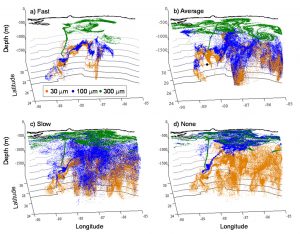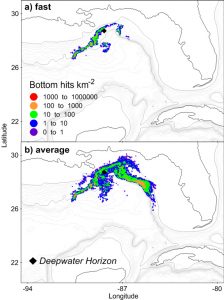Study Suggests Biodegradation Strongly Influences Oil Spill Transport Predictions
– October 8, 2015
Scientists simulated twenty subsurface spill scenarios, using data reflective of the Deepwater Horizon spill, and found large differences in transport predictions when model parameters included bacterial consumption (biodegradation) of oil droplets.
Simulations with biodegradation indicated that tiny oil droplets remained deeper by hundreds of meters and were less spread out by thousands of kilometers compared to simulations without biodegradation. Simulations with biodegradation indicated nearly all of the initial oil mass was dispersed in plumes of tiny droplets that doubled or quadrupled the seafloor area contacted by oil compared to simulations without biodegradation. The researchers published their findings in Environmental Research Letters: The influence of droplet size and biodegradation on the transport of subsurface oil droplets during the Deepwater Horizon spill: a model sensitivity study.
The team assessed the sensitivity of subsurface oil transport predictions to biodegradation rates and initial droplet sizes. They combined a plume model for calculating initial droplet depths, a three-dimensional hydrodynamic model for ocean circulation, and a Lagrangian model for oil droplet trajectories. They assumed fast to slow biodegradation rates based on observed alkane biodegradation and used five droplet sizes consistent with dispersant-treated oil in laboratories. Researchers compared model output with observations of hydrocarbons from the water column and sediment collected in the northern Gulf of Mexico during and after the Deepwater Horizon spill.
Their findings show that a better understanding of the factors that influence underwater oil transport is critical for improved predictions, particularly with chemically-dispersed oil that remains suspended longer than untreated oil. The longer that oil remains submerged, the more likely its path will be influenced by biodegradation and other natural processes. Lead author Elizabeth North said, “Biodegradation of hydrocarbons in deep and cold waters has been observed to be variable, and our model simulations show that this variation strongly affects how far oil droplets could be transported and where they might go before they decompose.”
Model output matched observations of subsurface hydrocarbon plumes to the southwest of the wellhead. Model output also indicated that oil droplets could have touched bottom on the continental slope to the northeast and east of the well. North explained, “The near-neutrally buoyant nature of subsurface plumes of tiny oil droplets enables them to be carried long distances before they intersect with continental slopes.” The authors acknowledged that that they cannot confirm this prediction with observations because little sampling was conducted in the sediments of the Florida slope. However, North said, “The understanding that plumes of tiny oil droplets could be transported tens to hundreds of kilometers away from a well head is important for monitoring and mitigating the impacts of deepwater spills. It also makes me wonder if the Florida slope could be where some of the ‘missing oil’ might be found.”
The study authors are North, E.W., Adams, E.E., Thessen, A.E., Schlag, Z., He, R., Socolofsky, S.A., Masutani, S.M., and Peckham, S.D.
**********
This research was made possible in part by a grant from the Gulf of Mexico Research Initiative (GoMRI) to the Gulf of Mexico Integrated Spill Response Consortium (GISR). Other funding sources included the National Science Foundation (RAPID: Deepwater Horizon grants OCE-1048630, OCE-1044573, CBET-1045831).
The Gulf of Mexico Research Initiative (GoMRI) is a 10-year independent research program established to study the effect, and the potential associated impact, of hydrocarbon releases on the environment and public health, as well as to develop improved spill mitigation, oil detection, characterization and remediation technologies. An independent and academic 20-member Research Board makes the funding and research direction decisions to ensure the intellectual quality, effectiveness and academic independence of the GoMRI research. All research data, findings and publications will be made publicly available. The program was established through a $500 million financial commitment from BP. For more information, visit https://gulfresearchinitiative.org/.
© Copyright 2010- 2017 Gulf of Mexico Research Initiative (GoMRI) – All Rights Reserved. Redistribution is encouraged with acknowledgement to the Gulf of Mexico Research Initiative (GoMRI). Please credit images and/or videos as done in each article. Questions? Contact web-content editor Nilde “Maggie” Dannreuther, Northern Gulf Institute, Mississippi State University (maggied@ngi.msstate.edu).







